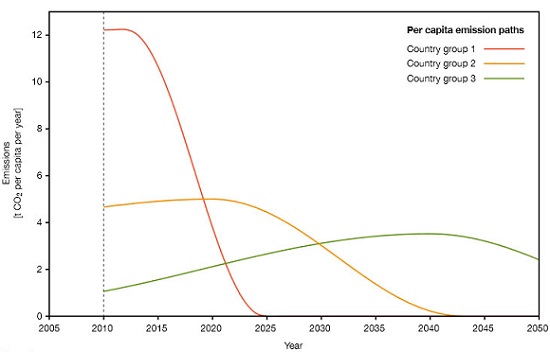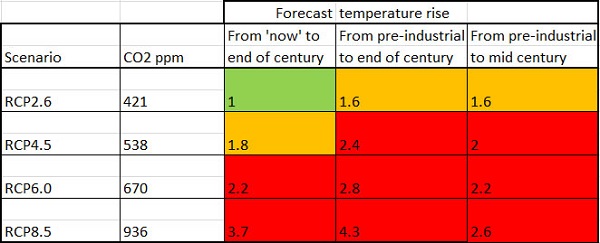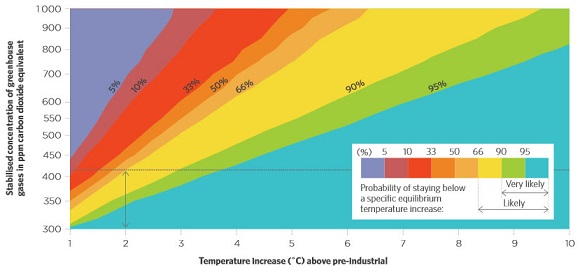Val at fairgreenplanet perceived two contrasting approaches to climate mitigation at the recent Australian Climate Action Summit:
- technology can get us there, with a bit of political will
or
- we have to change the way we live, starting from the local level
In relation to the first she also cited a recent post by John Quiggin who cites four major reports, all making the same point:
decarbonizing the world economy will involve economic costs that are
(a) small; and
(b) far outweighed by the benefits
So that’s a net gain of considerable dimensions.
This is supported at the country level by a recent report in the UK:
if the UK cut its carbon emissions by 60 per cent from 1990 levels by 2030, as it has promised, its GDP would be 1.1 per cent bigger than if it stuck with fossil fuels, says a study by consultants at Cambridge Econometrics.
About half the gain would come from cheap running costs for fuel-efficient cars, with 190,000 new green jobs and higher wages also helping. The average household would be £565 a year better off.
The four reports cited by Quiggin are as follows:
First, there’s Pathways to Deep Decarbonization an international collaborative project under the auspices of the UN.
Second, the Better Growth Better Climate report from the Global Commission on the Economy and Climate
Third, this report on Green Growth from the Center for American Progress (covers the US only)
And, most strikingly, this report from staffers at the International Monetary Fund, long the guardian of fiscal rectitude has concluded that for most countries, the local side benefits of reducing pollution would be sufficient to offset the costs for carbon prices up to $50/tonne.
I find each report has limitations in its own way, so at the end I remain agnostic.
The fourth, the IMF study, looks at carbon pricing in the top 20 emitters. As far as I can make out it comes up with two propositions. First, each country can act on its own, with benefit, no-one has to wait for the world to act. Secondly, it identifies a sweet spot, which varies quite a lot from one country to the next, where net benefits accrue from carbon pricing. In Australia’s case it’s only $11.50 per tonne.
This is all very promising but is not as such a plan for climate stabilisation at safe levels.
The third, the American study, finds the aim of reducing emissions by 40% from 2005 levels by 2035 doable and beneficial. The problem here is in the task identification. The study assumes that the US should decarbonise at the same rate as the rest of the world. It ignores the ‘carbon budgeting approach’ whereby high per capita emitters need to decarbonise rapidly to make space for developing countries to grow their economies. See Figure 5 of this post on the IPCC report. The United States is a Group 1 country, which must decarbonise rapidly:

As we saw in this post, two thirds of increased emissions are now coming from emerging and less developed countries. In other words in reality increases from Group 2 and 3 countries are not being offset by cuts in Group 1 countries. Until we get our heads around this issue and address it we’ll stumble along on the road to perdition!
The problem facing Group 1 countries is impossible. The way around it lies in emissions trading between rich and poor countries, as per Figure 6 in that post. This would entail considerable wealth transfer, which could be mandated to be used in greening developing country economies.
Also 40% by 2035 overall is not a recipe for a safe climate, as shown below.
The first study, has two limitations. Firstly it simply does not address the issues of economic costs and social implications. Secondly, it simply accepts the stabilisation pathway for a 2°C temperature increase which sees zero worldwide emissions about 2070. In looking at the IPCC report (same as linked above), I developed this table to relate concentrations to temperature rise. RCPs are Representative Concentration Pathways (RCPs) which are expressed in terms of watts per square metre of radiative forcing (W m-2). Roughly, RCP2.6 represents the 2°C pathway, while RCP8.5 represents our present path.

Green indicates a comparatively ‘safe’ climate, orange indicates the increasingly contested zone which clearly carries some danger, and red to indicate breaching the 2°C guardrail which everyone with half a brain accepts as dangerous.
Strictly speaking the green box should be orange, because it sits on top of ‘now’ which is an 0.6°C increase, and the orange box below it should be red, for the same reason.
On the orange zone, the Climate Change Authority in its Review published this wondrous graph, showing that they were well aware of the inadequacies of a 2°C target:

As I said then, in terms of CO2 equivalents we are now at 480. This gives us less than 33% chance of staying below 2°C and about a 10% chance of exceeding a civilisation threatening 4°C. These odds are unacceptable. We are already in an overshoot situation.
This is old information – very old. James Hansen told us at an American Physical Union meeting in December 2007 that we needed to aim for 350ppm in the first instance and then decide where we go from there.
The RCP2.6 path involves a 33% chance of ending up with more than 2°C, odds that should be completely unacceptable.
Turning to the third report, which specifically addresses the financial implications, it too is on 2°C path. The costs numbers when taken in isolation look large (US$45 trillion will be required in 2015–2030 for key categories of energy infrastructure), but in context are trivial:
costs of this magnitude look like “background noise” when compared with the strong underlying growth that the global economy is likely to experience.
These costs will go up if mitigation is delayed:
Costs are also likely to rise sharply with delay. If global action to reduce emissions is delayed until 2030, global CO2 emissions would have to decrease by 6-7% per year between 2030 and 2050 in order to have a reasonable chance of staying on a 2°C path. Such rates of reduction are unprecedented historically and are likely to be expensive (estimates of delay suggest an average annual consumption growth loss of around 0.3% in the decade 2030 to 2040, compared to a loss of less than 0.1% over the same period if we act now).
Fine, and perhaps not yet serious, but I’m afraid completely out of date. In 2011 the Climate Commission published this graph to illustrate the implications of delay:

Under the ‘climate budget approach’ the area under the line must remain constant.
That too would have been based on a 2°C target, but it illustrates that if we delay peaking emissions worldwide, even to 2020, we’ll be in completely uncharted territory.
Chapter Five of the third report gives enormous detail of the policy work that needs to be done. It may be summarised as strong leadership, consistent policy over decades, structural change and perhaps unprecedented international co-operation, even if we start now on a task that is eminently doable and inexpensive; so more than “a bit of political will” is required.
Frankly, our best hope lies in the prospect that solar technology with storage will simply become the cheapest form of new energy, and has the advantage that it doesn’t need a large grid. Nevertheless there will be residual problems – land use and agriculture, transport, ocean acidification etc. Zero emissions transport will require planning and subsidies.
One thing we should realise, however, is that further out our future will be energy rich, not energy-constrained. Saving energy is not a reason for localism and changing the way we live.
So where does that leave Val’s second option?
Firstly, concerted long-term action and international co-operation of the kind we need is not in our DNA. We are designed to co-operate in bands of up to 150 people, the number that our big brains can cope with in terms of knowing in any detail. We are told Fukuyama, Harari for example that bands were relatively egalitarian with a leader answerable to the people. Beyond that we can co-operate in amazing ways, but at the price of setting up hierarchies and privileges, coercive elites. This occurred in general with agriculture and owning stuff, even herds. These problems can be ameliorated in a modern democratic nation-state, with it’s formal mechanisms for election, administration, justice and accountability, but we are still apt to act in the self-interest of that larger entity.
What we need is an infusion of new values and ways of perceiving, thinking and feeling. While not sacrificing individualism we need to feel and act as social beings. We also need to revalue ourselves in relation to the biological and physical systems of the planet, so that we stop acting like the top rapacious predator, the one that has decimated the wild animal kingdom by 52% since 1970. Along the way, we need to challenge a Chain of Being, that sees elite mostly European males as next to the gods and women, children, other races, other social classes, slaves, asylum seekers etc in subordinate positions.
We need to live in nature, not over nature.
While localism and social participation are necessary, the required cultural and existential changes are hard work will happen over generations if at all. The planet can’t wait. That last reference tells us:
Efforts have been made to economically quantify the world’s “stock” of natural capital and the yearly “flow” of ecosystem services they provide. The latest numbers are $142.7 trillion and $48.7 trillion, respectively. By comparison, the flow of incomes through the global economy is currently about $71.8 trillion per year. The research suggests that by 2013 we were eliminating that stock of natural capital at a rate of about $7.3 trillion per year, and that the flow of ecosystem services would be $23 trillion higher if not for human practices like deforestation, burning fossil fuels, and the like.
And underneath all this, there is the point that these creatures and the ecologies they inhabitant have an intrinsic moral worth irrespective of the dollar sign that markets can place on them. “Wildlife is and should be useless in the same way art, music, poetry and even sports are useless,” author Richard Coniff recently wrote in the New York Times.
And the climate can’t wait.
We need hierarchies to get things done, a collective will not build a battleship, but we need to civilise them and render them accountable. We even need coercive powers, to counter the selfishness of states. The only supra-national entity that the major powers take notice of is the World Trade Organisation, not the UN. We need it to police international agreements, to oversee international carbon trading, and what Quiggin’s third report calls “border carbon adjustments”.
I never thought I’d say that!
The bottom line is that we must act if we want a future for our grandchildren, and cost, the only certain Armageddon is if we do nothing or not enough. We are heading into uncharted territory but indications are that there will be benefits and the net costs are unlikely to be as bad as pessimists might think. We just don’t know. And the groupie, local stuff, well there are reasons for doing that, but it won’t solve climate change as such.


Brian
You say;
Yet quote ” reports in the UK ” saying the non- fossil fuel is better for gdp growth.
I guess my question is why not have developing countries start with renewable energy, if its better for gdp, than have them transition later ( at massive cost)?
Why do they need the fossil fuel leg up if non-CO2 better for their economy?
jumpy, circumstances will vary. What’s best for one country may not be best for another.
Also, they’ll do what they’ll do and not always for the best.
Brian: I think that the WTO is part of the problem. Climate action would be a lot more attractive to many countries if more of the jobs created by climate action stayed in the countries taking the action. Unfortunately, the WTO rules mean that the solar panels etc. end up being imported instead of made in the country taking the action.
In addition, WTO rules mean that, if climate action really increases cost Australian business finds it harder to compete.
Brian: If you look at rooftop solar it is an examples of individuals being empowered to act. However, to make panels you need the materials, knowledge and process. This only comes with a large enterprise (which may be split over a range of organizations and countries.
Brian thanks! So much to comment on, I don’t know where to start, but I really appreciate all the work that’s gone into this.
I think I’ll just start with one thing – I’m pretty sure you’ve read Bill Gammadge ‘Biggest estate on earth’? The big point about that – as the title tells you – is that the tribes, or clans, whatever you want to call them, cooperated through the Law, or Dreaming, to manage the whole land of Australia. That flies in the face of the arguments you point to about only cooperating in small groups.
That’s really the kind of model I’m thinking of – egalitarian, cooperative teams that are networked into larger structures, which are still egalitarian. And my further point was, we don’t actually have to change ourselves fundamentally (as you suggested in an earlier post), we already do operate that way a lot of the time already. It’s just that that way of operating (cooperation, mutual caring) tends to be taken for granted, while the competitive hierarchical way is seen as more important or dominant. However I argue it is the discourse of patriarchy that has made us see that as the ‘natural’ way of organising ourselves, rather than it being in any real sense more natural or more effective than cooperation.
So I’m calling for us to bring that egalitarian, cooperative, caring side of ourselves to the forefront, because it’s what we really need right now. It doesn’t involve changing ourselves fundamentally, it just involves bringing the ‘taken for granted’ to the light and seriously thinking about how it does and can work.
Also in many ways these ideas are the core of democracy, after all.
Val, I think there is quite a lot of agreement between us although the words may not match exactly.
I haven’t read Gammadge – obviously I should. Harari (Sapiens: a brief history of humankind) says that our genetic/biological make-up allows us to genuinely co-operate in a flexible way in groups of up to 150. Other species (bees, ants, etc) co-operate in larger groups, but inflexibly. In terms of ‘fundamental’ changes, we can’t change that.
Sapiens big leap forward, however, was to co-operate in much larger groups, again flexibly. He says we do this through myths, values, stories, language etc. In the past these have been determined largely by elites acting through hierarchies. The means of doing this beyond the nation state level in a democratically accountable way are not very mature or effective. The UN makes decisions largely through consensus, as does the WTO. In practice you find big powers and special interest elites having undue influence. The European Union mill grinds slowly but in many dimensions the ‘democratic deficit’ is a problem. The Brussels bureaucrats tend to rule.
In the modern era, from the Renaissance really, individualism has been privileged as against a view of ourselves as primarily social beings. It’s embedded in our culture and permeates our child-raising practices. In a sense this is a distortion of what is natural. Correcting this is what I’m talking about in fundamentally changing ourselves. I see it as a necessary part of overcoming all the hierarchical dualisms, not just the gendered one.
However, hierarchies are going to exist and have their uses. To build a battleship, or even make solar panels, activities across a number of countries are going to have to be co-ordinated and brought together. Someone or some group needs to focus on the broader functions and bring then together in an effective way. But there is no reason why the management of a corporation can’t be democratised. There was a lot of talk about that in the 1970s. The EU mandates that corporations must have worker representatives on management boards. In the Anglo world this tends to be seen as anathema.
John, the WTO is going to be around, and formally at least its rules are created by consensus between all members. In practice there are shysters at work.
But we need to get inside the tent if anything is going to change.
Val, imagining different futures is hard and necessary work, especially because taken for granted reality is routinely seen a ‘natural’. If we all imagine a different world then the world will change.
The reality of most organizations is that the formal hierarchy is only vaguely related to the real flow of power. The real flow of power is related to people’s perception of expertise, ability to get certain things done, influential friends etc.
Getting things done from outside an organization are a lot easier when you understand this real flow of power, who you need to get onside, their current concerns, the language/buzzwords they take notice of, etc.
The same is equally true for the sort of organizations that Val is talking about. There will be a flow of power and some people will be far more influential than others. Europeans often have problems dealing with Aboriginal groups because the flow of power is difficult to determine and signs that mean someone has power in our society don’t necessarily mean that that person has power in their society.
I think that the climate action movement has wasted a lot of time demanding that “leaders” show the political will to do things that they haven’t really got the power to do. The climate action movement has also wasted a lot of time focussing top down driven, simplistic solutions like the carbon tax instead on focussing on solutions that can be done by individuals, local governments etc.
It is no coincidence that over 20% of Qld households have rooftop solar (and growing despite Newman’s hostility) compared with negligible utility scale.
Libertalia ?
One thing I think important is to distinguish between authority and inequality. So you could have people or teams who have authority to make decisions that others are affected by, but they don’t have to be paid more (they are not seen as having a greater claim to the world’s resources).
My theory is that where people aim to share fairly, they are also more likely to conserve and not over-use the earth’s resources. Relating this to what Brian said about individualism, if you think only about yourself and ‘your’ family, then you get what you can for yourself. If you think as a member of a community, including future members, then you think about using resources sustainably.
I wasn’t aware till lately of the way ecologically minded farmers use the word “community”, to include plants ( or sometimes just referring to a plant community) – I really like it. I will send some more info about these farmers soon (or put it on my blog) because it’s really interesting.
John D @ 9, useful comments about the flow of power.
John, bottom up, 20% solar, 40% solar, or whatever is not going to get us there. We need top down and bottom up and every which way.
Specifically, I think international emissions trading is going to be needed as part of burden sharing and giving the poor countries sufficient resources to develop in a clean and sustainable way.
Brian,
We have been stuffing around for years trying to set up variations on the ETS, international agreements etc. etc. All they have achieved is ????
The action that is happening is happening outside of of the great big schemes.
Do you wonder why I am a skeptic of great big schemes? They tend to be an excuse for doing nothing.
John, similarly I could say we’ve been stuffing around for years with small scale schemes and direct approaches. The net result is that emissions continue to rise every year!
I don’t have the comfort of certainty like you, but I suspect that if we are to squeeze out emissions in the 50 to 100% range we are going to need an international approach that involves emissions trading along the lines of the ‘climate budget approach’.
Brian: You might be right. Large scale concerted action is more likely to take place as a result of the dramatic price reductions that the small scale actions have driven.
Brian: It is worth noting that it is contract based FIT schemes, not the ETS, that has driven European renewable investment. ditto renewable energy in Qld where there has been almost no large scale investment.
If we are really serious about emissions we need to go on a war footing. War footing means hairy chested direct action like our Snowy Mountain Scheme (which I believe was a mixture of contract and government action. It certainly wasn’t all about manipulating prices, trading schemes and all the other things economists get warm and fuzzy about.)
John, I’ve never seen an ETS as the first or the main thing you’d do in getting emissions down 50%. I think, however, an ETS will need to be part of the toolkit in getting from 50% to 100% worldwide.
To get to the end point we have to ramp down the extraction of fossil carbon to zero. An ETS style permit sale system might help that happen,